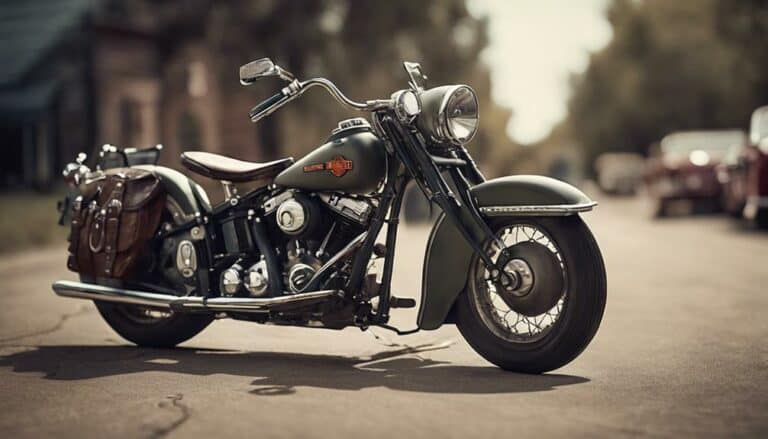If you were to step into the Harley-Davidson showroom in 1941, you would come across a lineup that included the UL, WL, EL, and Servi-Car models alongside the iconic Knucklehead. Each model brought its own unique features and characteristics to the table, catering to a diverse range of riders and preferences.
As you explore the details of each of these offerings from Harley-Davidson in 1941, you will uncover a blend of innovation, tradition, and practicality that defined the brand's approach during that era.
Key Takeaways
- Harley-Davidson offered the Knucklehead series with models like E, EL, ES, and 74 cubic inch variants in 1941.
- The UL model with a 74 cubic inch engine and enhanced clutch was introduced in 1941.
- The WL model, a 45 cubic inch V-twin, continued its versatile performance in 1941.
- The iconic Servi-Car, a three-wheeled utility motorcycle, was part of Harley-Davidson's lineup in 1941.
Harley-Davidson Knucklehead
The Harley-Davidson Knucklehead, introduced in 1936, revolutionized the motorcycle industry with its innovative 61 cubic inch EL hemi overhead valve engine. This groundbreaking engine design featured distinctive cylinder heads resembling a clenched fist, hence the name 'Knucklehead.' The overhead valve configuration allowed for improved airflow and increased power output compared to side-valve engines, setting a new standard in motorcycle performance.
The Knucklehead lineup in 1941 included the base E model, the EL for Special Sport enthusiasts seeking extra power, and the ES tailored for sidecar use. The addition of a 74 cubic inch model that year aimed to boost overall performance and keep up with the demands of riders. These models were equipped with a gear-driven centrifugal pump to ensure proper oil supply, enhancing engine durability and performance on the road. The enhancements made to the 1941 FL model were a strategic move by Harley-Davidson to compete fiercely with Indian Chiefs in the motorcycle market, showcasing the brand's commitment to innovation and excellence.
Harley-Davidson UL
Introducing the Harley-Davidson UL model in 1941, a robust large-frame motorcycle featuring a 74 cubic inch engine. This iconic bike boasted 16-inch wheels as standard, offering stability and a smooth ride. The 1941 UL model also sported a new clutch with enhanced frictional area, ensuring improved performance. Despite minimal changes from previous models, the UL stood out for its reliability and power.
In 1941, Harley-Davidson faced increasing demands from the US military, leading to limited updates on civilian models like the UL. This peacetime production year marked the final opportunity for riders to experience the UL before the onset of World War II shifted priorities for the company. Today, restored 1941 Harley-Davidson UL models hold a special place in history, with some even coming certified by Automotoclub Historico Italiano, highlighting their significance and craftsmanship. The 1941 UL remains a symbol of freedom and strength, capturing the essence of Harley-Davidson's legacy.
Harley-Davidson WL
In 1937, Harley-Davidson introduced the WL model, a 45 cubic inch flathead V-twin motorcycle designed initially for military purposes during World War II. The WL, part of the E and F series, continued to evolve and improve, becoming a symbol of freedom and adventure in 1941.
Here are three key points about the Harley-Davidson WL in 1941:
- Enhanced Performance: By 1941, the WL had undergone refinements to enhance its performance on various terrains, making it a versatile and reliable choice for riders seeking excitement and liberation.
- Sturdy Design: The WL's rugged design made it well-suited for both urban streets and off-road escapades, giving riders the confidence to explore new horizons and embrace the thrill of the open road.
- Iconic Legacy: In 1941, the WL model continued to solidify its iconic status, embodying the spirit of freedom and individuality that Harley-Davidson motorcycles are known for.
Harley-Davidson EL
Revolutionizing the motorcycle industry in 1936, Harley-Davidson EL debuted as the premier fully overhead valve street engine model. The EL model featured a powerful 40 bhp, 61 cubic inch engine, affectionately called the Knucklehead due to the shape of its cylinder heads. By 1941, Harley-Davidson boosted the EL lineup with a 50 bhp, 74 cubic inch model, offering riders even more power and performance on the road. Coupled with a four-speed gearbox, the EL provided a smooth and exhilarating riding experience for enthusiasts seeking the thrill of the open road. The introduction of a gear-driven centrifugal pump in 1941 further enhanced the EL's performance, addressing initial oil flow challenges and solidifying its reputation as a top-tier big twin motorcycle. The EL model continued to captivate riders until 1947, leaving an indelible mark on the history of Harley-Davidson.
| Harley-Davidson EL | Specifications |
|---|---|
| Engine | 40 bhp, 61 cubic inch |
| Year Introduced | 1936 |
| Additional Model | 50 bhp, 74 cubic inch (1941) |
| Production Years | 1936-1947 |
Harley-Davidson Servi-Car
The Harley-Davidson Servi-Car, a three-wheeled utility motorcycle introduced in 1932, served a crucial role in commercial and police operations with its distinctive design and functionality.
- Versatile Utility: The Servi-Car was specifically designed for commercial purposes, featuring a spacious rear cargo area that could be customized for various tasks such as delivery services, towing, and maintenance operations.
- Powerful Engine: Equipped with a 45 cubic inch flathead V-twin engine, the Servi-Car provided reliable power for its day-to-day operations, making it a dependable workhorse for businesses and law enforcement agencies.
- Long Production Run: Production of the Servi-Car spanned over four decades until 1973, solidifying its place as one of Harley-Davidson's longest-running models. Its enduring popularity was a statement to its durability and practicality in a wide range of commercial applications.
Conclusion
You have explored the various models that Harley-Davidson offered in 1941, including the Knucklehead, UL, WL, EL, and Servi-Car. Each model showcased the brand's commitment to innovation and quality during a time of shifting priorities.
By understanding the historical significance of these models, you can appreciate Harley-Davidson's enduring legacy and the evolution of motorcycle design throughout the years.
Ride on with pride in the knowledge of Harley-Davidson's rich history.

